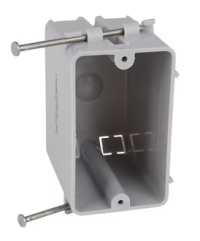steveray
SAWHORSE
I'm not paying for that....There’s a paywall.
Your premier resource for building code knowledge.
This forum remains free to the public thanks to the generous support of our Sawhorse Members and Corporate Sponsors. Their contributions help keep this community thriving and accessible.
Want enhanced access to expert discussions and exclusive features? Learn more about the benefits here.
Ready to upgrade? Log in and upgrade now.
I'm not paying for that....There’s a paywall.
Well Shirley you get a front row seat.I'm not paying for that....
Noooo.... Ground up...Everyone knows that....The box needs an up arrow so that the ground prong is on the bottom. The same with a switch.
This is a nice feature. But you would need right and left.View attachment 15394
Only if it is for Bill in an office setting.Noooo.... Ground up...Everyone knows that....
And then you have to put in twice as many outlets to make up for the IECC controlled receptacles....Not that I like to get off topic,,,,Only if it is for Bill in an office setting.
I was referring to the temporary cover.It is! The Ez2Wire mounting boxes are made out of the exact same materials used in current boxes and will be manufactured by the same companies make the boxes we use today.
My bad. I missed that context.I was referring to the temporary cover.
Valid question.Do these work for data as well? CAT whatever? other?
Your Statement… A pop-in tab similar to the back of a receptacle (thin blade screwdriver is used to release the wire) could be introduced to prevent a devise pull out as discussed previously.Mark, very impressive I could see this product in the big box stores with a marketing team getting shelf space in the near future.
A pop-in tab similar to the back of a receptacle (thin blade screwdriver is used to release the wire) could be introduced to prevent a devise pull out as discussed previously.
With the size of the devise body, is there any concern with heat build-up inside the box?
You will probably want to be ready for installation in fire-rated assemblies.(Ventilated or Waterproof)
In addition to providing a mounting for a device, outlet boxes also serve to contain molten metal. Extra holes are not encouraged.Our current design has Punch-Out air vent ports, top & bottom of each bay
I was thinking the same thing, but then again, wouldn't that be covered by a UL (or similar) listing?Box fill codes may need to be addressed or modified. Will need devise calcs for calculating fill if not already done.
GFCI and AFCI's, will they be available?
Dedicated receptacles?
Someone is probably going to pay for a whole new standard....UL or ETL will be hauling in the dollars.
That could take years. I was on the panel for UL2703 for two years and didn’t make a lot of headway. Even getting a listing would mean dealing with several Standards.Someone is probably going to pay for a whole new standard....
I'll add that to my To Do list! ThanksYou will probably want to be ready for installation in fire-rated assemblies.
Can you clarify? I don’t understand the need or requirement to contain molten metal.In addition to providing a mounting for a device, outlet boxes also serve to contain molten metal. Extra holes are not encouraged.

It is my understanding that 'box fill codes' are drafted and codified to address the space needed to safely house the number of wires and caps that are typically pulled, twisted, and stored in the box behind the device (switch(s)).Box fill codes may need to be addressed or modified. Will need devise calcs for calculating fill if not already done.
GFCI and AFCI's, will they be available?
Dedicated receptacles?
Here's the thing... The Ez2Wire system is just a simplified connection methodology. Each OEM will use their existing, previously approved, switches and receptacles. They will just make minor modifications to connect their existing devices with our switch back housings. This process is typically an automated process at their factory. Just replacing their rear housing with ours so that their devices mate with the Ez2Wire boxes with tight tolerance precision.UL or ETL will be hauling in the dollars.
